Harmony Order and Balance in a Work of Art Are Characteristic of
The principles of art (or the principles of design) are essentially a set of criteria which are used to explain how the visual elements are arranged in a piece of work of art. These principles are peradventure the closest thing we have to a set of objective criteria for analyzing and judging art.
Art is a notoriously gray area when it comes considerately defining what is great and what is not. An artist of 1 era may be mocked during his lifetime, yet revered subsequently his passing (such as Vincent van Gogh). The principles of fine art help combat this gray area to some extent. They allow us to communicate what makes a not bad painting great with an element of objectivity and consistency.
The following is an explanation of what the principles of art are and how y'all tin utilize them to do good your ain artworks.
Design
Pattern is a very of import design concept which refers to the visual organisation of elements with a repetitive form or intelligible sequence.
Pattern is non always obvious. It could be a uncomplicated underlying notan blueprint which dances between lite and dark in some kind of sequence. Or it could be the utilize of similar color patterns throughout your painting.
In the painting below, notice how the top arm of the subject almost blends into the background, and how the legs alloy into the cloth, and the fabric blends into the rest of the foreground. This interlinking pattern drags yous through the painting and creates a very interesting design.
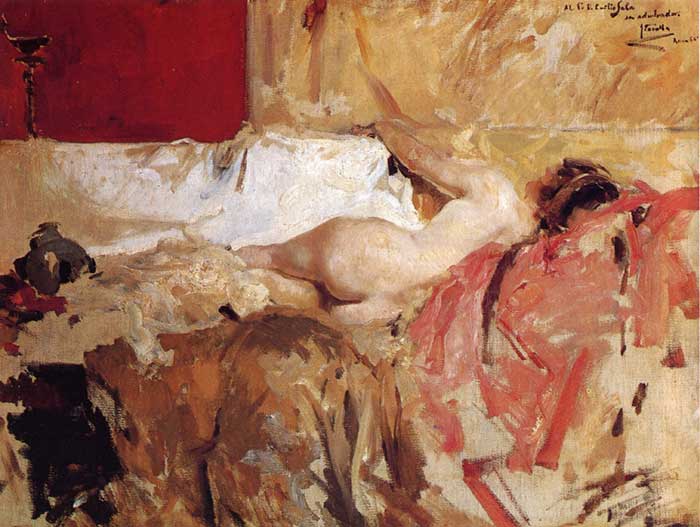
Joaquin Sorolla, Bacchante, 1886
Read more well-nigh pattern in art.
Balance
Balance is concerned with the visual distribution or weight of the elements in a piece of work of fine art. A painting could be balanced if one half is of the same visual weight as the other half. Or, you lot could have a modest area of heightened significance which is balanced against a much larger expanse of less significance, like in the painting beneath. In the painting below, notice how the dark areas used for the boat and foreground appear counterbalanced against the much larger area of soft, tinted colors.

Efim Volkov, Seascape, 1895
Accent
Emphasis is a manner of using elements to stress a certain expanse in an artwork. Accent is really but some other way to describe a focal signal in your artwork. In the painting beneath, in that location is strong emphasis on the moon through the use of colour dissimilarity.

George Henry, River Landscape By Moonlight, 1887
You tin can read more virtually emphasis in art here.
Contrast
Contrast is everything in fine art. Without information technology, an artwork would be null but a blank surface. Dissimilarity can come up in many forms:
Texture dissimilarity: A contrast between smooth and textured. Many of Vincent van Gogh'due south paintings are groovy examples of texture dissimilarity in activeness.
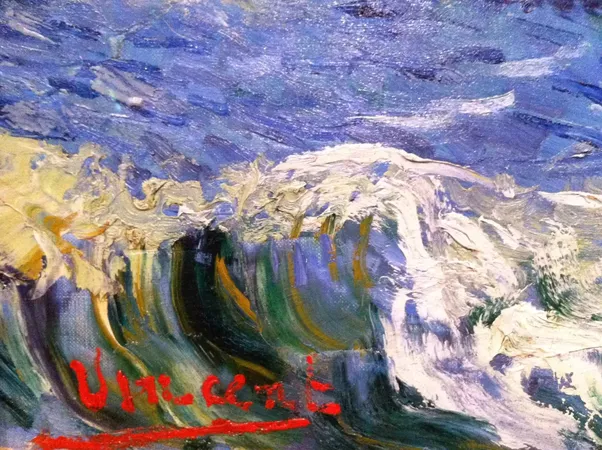
Color contrast: A contrast between light and dark, saturated and dull or complementary colors (hue contrast). For example, in the painting below, the highly saturated red contrasts against the relatively dull colors in the residual of the painting.
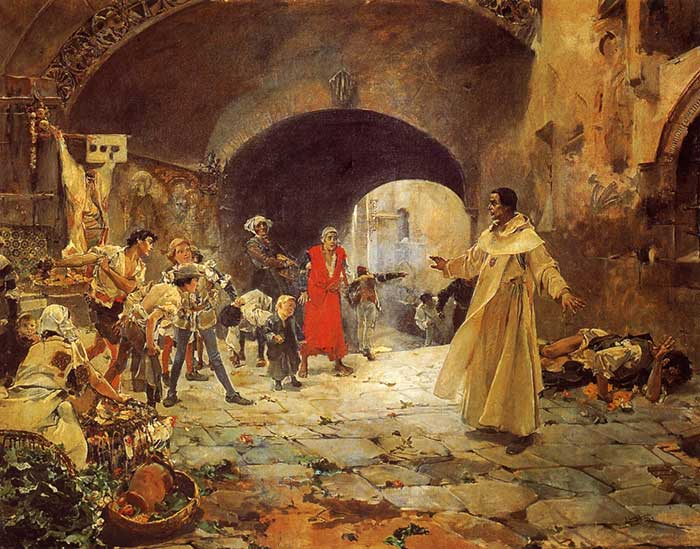
Joaquin Sorolla, Male parent Jofre Protecting A Madman, 1887
Item contrast: A dissimilarity betwixt areas of detail and more bland areas, similar in the painting beneath.
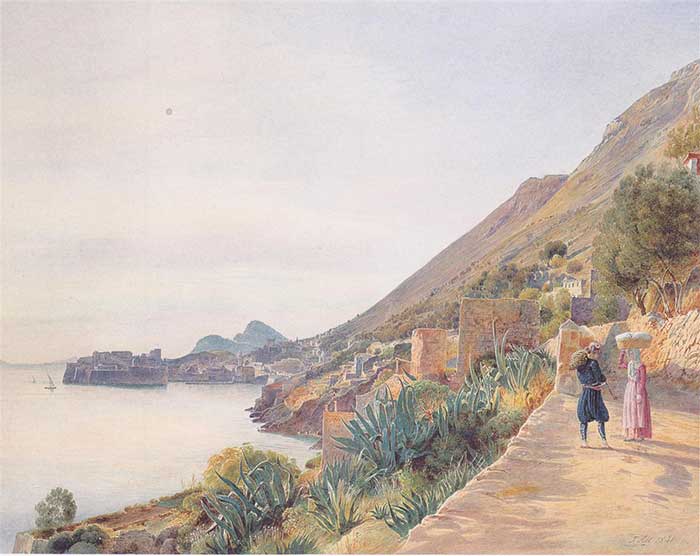
Rudolf von Alt, View Of Ragusa, 1841
Shape dissimilarity: A contrast between different shapes (rectangles and circles). For case, in the painting there are the curving shapes created by the winding paths, h2o and copse contrast confronting the rectangular shapes of the buildings.
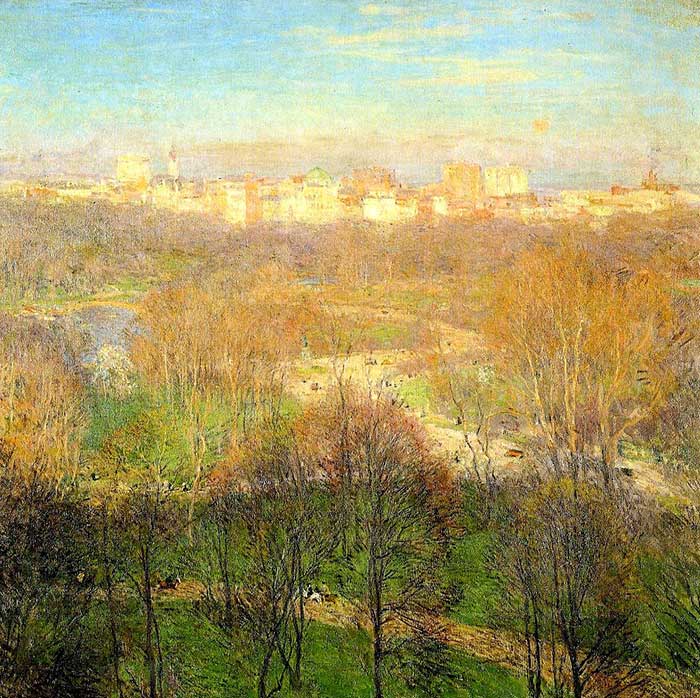
Willart Metcalf, Early Spring Afternoon, Central Park, 1911
Interval contrast: A contrast between long and brusque intervals. In the painting below, discover the variation in the lengths of the intervals between the copse. The interval contrast can be used to create a sense of rhythm in your artwork.
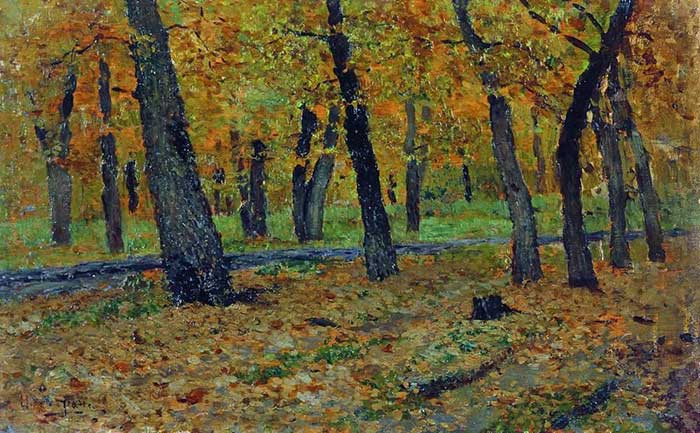
Isaac Levitan, Oak Grove, Autumn, 1880
Read more about using contrast.
Harmony And Unity
Harmony is a bit vague compared to some of the other principles. Generally speaking, it refers to how well all the visual elements work together in a work of art. Elements which are in harmony should have some kind of logical progression or human relationship. If there is an element which is not in harmony with the rest of an artwork, it should stick-out and exist jarring to look at. Kind of similar an off-note in a song.
You will usually exist able to tell merely from judgment if all the elements are in harmony. It will just look right. Yet, if the painting looks off, then it can exist hard to tell if that is because in that location is no harmony between the elements or if in that location is some other issue.
When I call up of harmony, I think of the peaceful arrangements of color in Monet'southward series of water lilies.

Claude Monet, Water Lilies, 1908
Unity refers to some kind of connection between all the visual elements in a work of art. Similar harmony, this is a bit of a vague term which is difficult to objectively use to analyze art. The painting below demonstrates a strong sense of unity through the use of a similar hues used throughout the painting. Even though there is a strong dissimilarity between the lite and night areas, at that place is a sense of unity created through the apply of similar hues (dark yellows, oranges and greens are used in the foreground and light yellows, oranges and greens are used in the background).
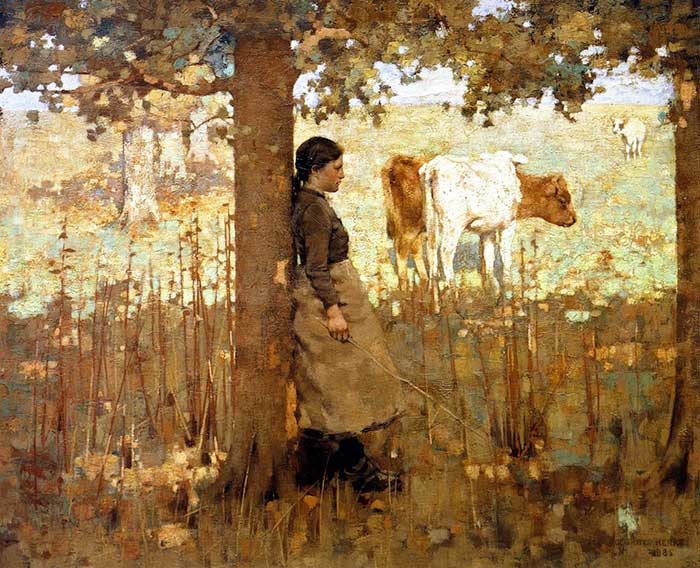
George Henry, Apex, 1885
Read more about using harmony.
Variety
Variety refers to the use of differing qualities or instances of the visual elements. Variety tin exist used to break up monotonous or repetitive areas.
Beneath is a painting with lots of variation in color, shape and texture, yet not then much that it loses any sense of harmony.
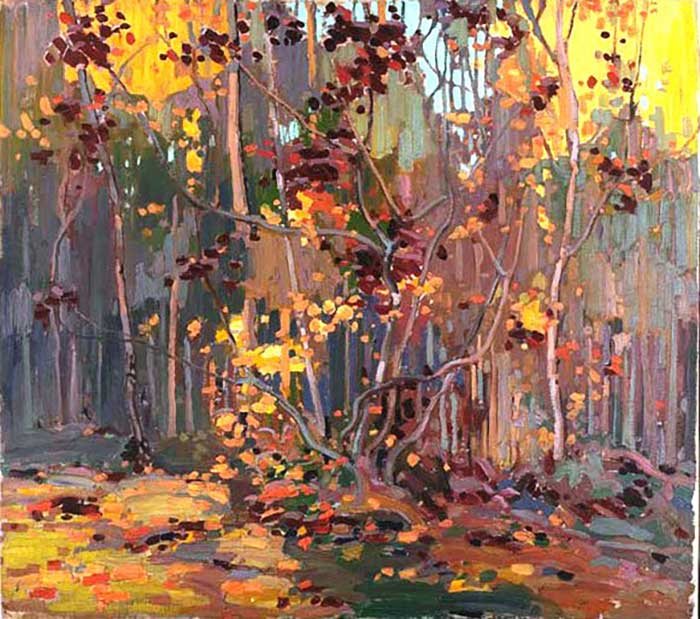
Tom Thomson, Maple Saplings, 1917
Beneath is a painting with insufficiently less variance. The result is a much calmer painting.
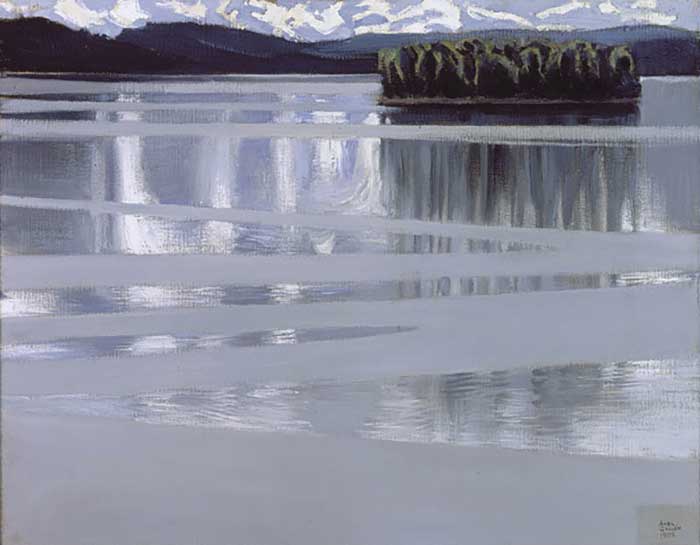
Lake Keitele, Akseli Gallen-Kallela, 1905
Movement
Your paints cannot physically move, only you lot can arrange the paints in a fashion which gives the illusion or proposition of movement.
1 of the most effective techniques for creating movement in your painting is to use bold and directional brushwork. Past doing this, you tin suggestively push your viewer around the painting as you lot please. You could also suggest movement through repetition or blueprint.
Beneath are ii examples of paintings which demonstrate a great sense of movement.

Joaquín Sorolla, Bounding main And Rocks - Javea, 1900
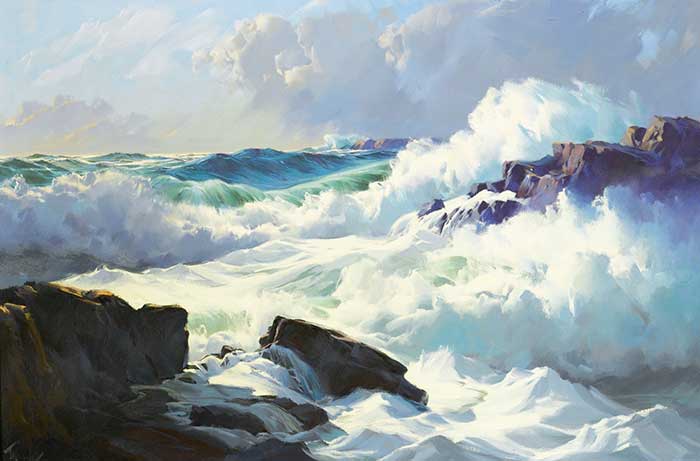
Frederick Judd Waugh, Breaking Surf
Also, I could not talk about using movement in art without some mention of Vincent van Gogh.
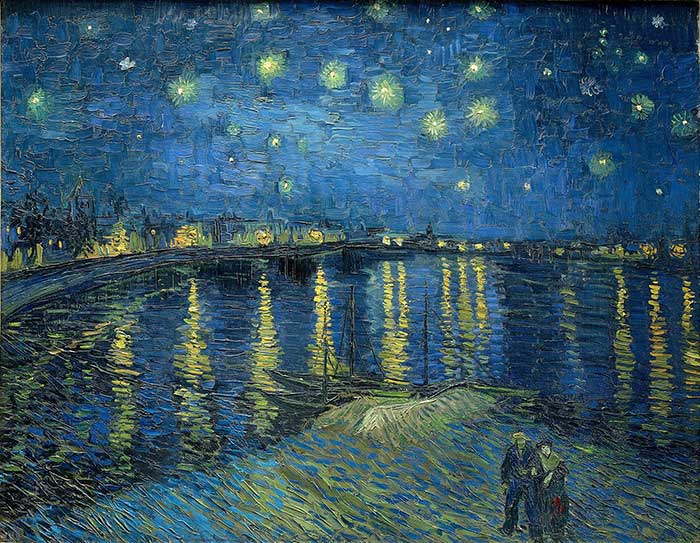
Vincent van Gogh, Starry Night Over The Rhone, 1888
Read more about movement in art here.
Proportion
Proportion concerns the relationship betwixt the sizes of different parts in an artwork. For example, the width compared to the length, the area of the sky compared to the state or the expanse of foreground compared to the background.
Some proportions are considered to be visually pleasing, such as the rule of thirds and the golden ratio.
In the painting beneath by Giovanni Boldini, discover how the proportions of the female subject'southward easily, face, feet and torso are all accurate. If Boldini painted the mitt too large compared to the residuum of the subject'south body, in that location would be an consequence of proportion.
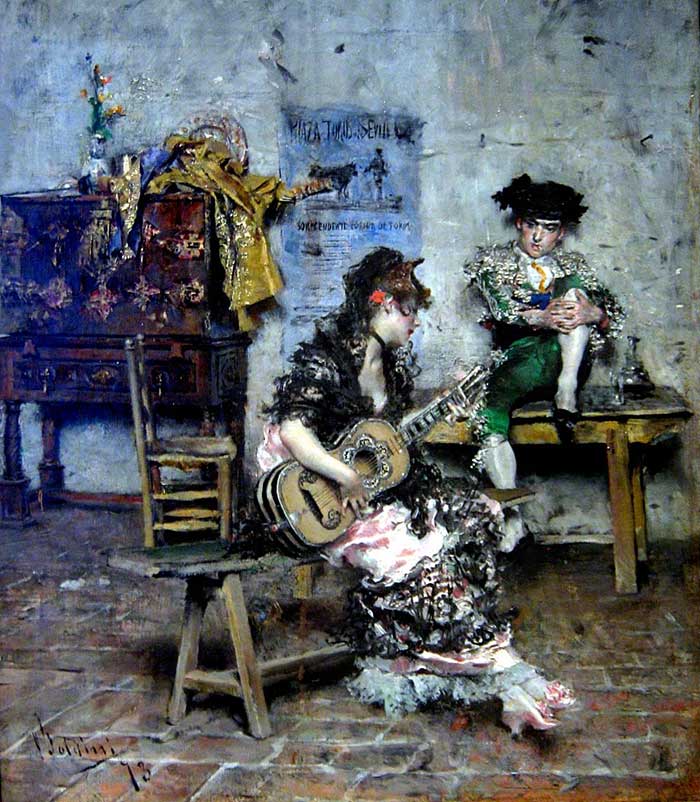
Giovanni Boldini, A Guitar Player, 1873
Calibration
Calibration refers to the size of an object compared to the rest of the surround. For example, the size of a homo compared to the tree he is sitting nether or the size of a mountain compared to the clouds. Scale is dissimilar to proportion in that calibration refers to the size of an unabridged object whereas proportion refers to the relative size of parts of an object. For example, the scale of a man relative to the rest of the painting may be right, but the proportion might be incorrect because his easily are also large.
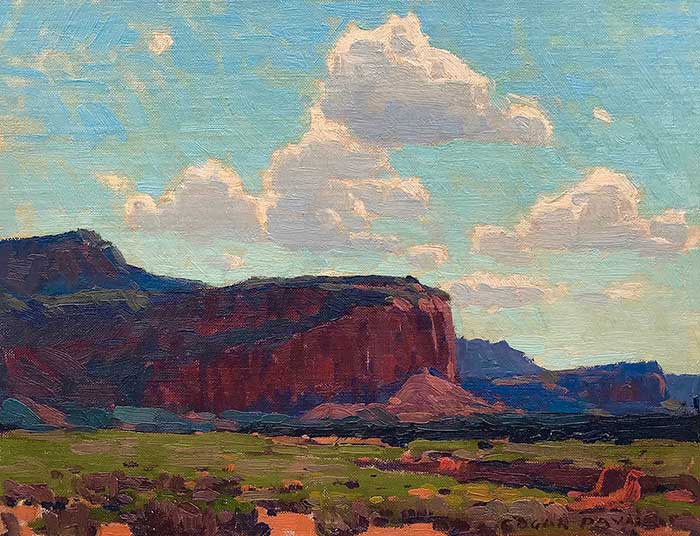
Summary Of The Principles Of Art
I hope this post clarifies to yous what the principles of fine art are and how you can employ them to help understand and communicate your thoughts about art.
Information technology is too important to understand that a not bad painting does not take to tick all the boxes in terms of the principles of art. Most of the great paintings will just demonstrate a few of the principles.
And then do non call back of the principles of art as a set of overarching rules which yous must comply with. They are but a way to assist usa understand and communicate our thoughts about art.
The principles of fine art permit us to place some kind of objective reasoning backside why a corking painting is great. This is important equally it keeps us from falling into a vague space where art is no longer able to be defined or critiqued (much like what has happened with modern art).
(If you want to learn more most the principles of art, you might be interested in my Painting Academy course.)
barcusmindighisent.blogspot.com
Source: https://drawpaintacademy.com/principles-of-art/
0 Response to "Harmony Order and Balance in a Work of Art Are Characteristic of"
Postar um comentário